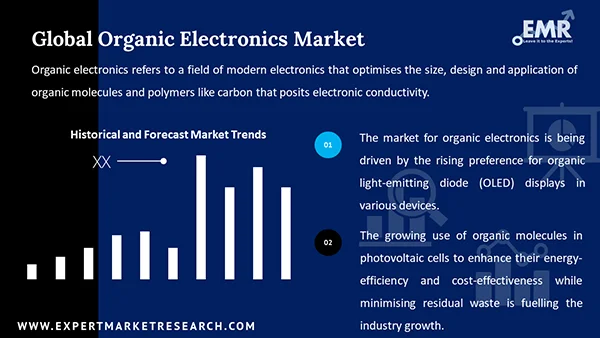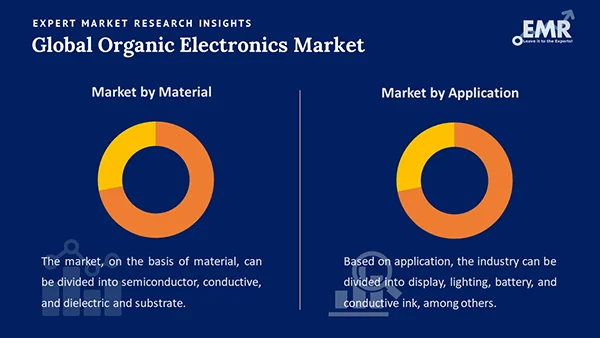
Consumer Insights
Uncover trends and behaviors shaping consumer choices today
Procurement Insights
Optimize your sourcing strategy with key market data
Industry Stats
Stay ahead with the latest trends and market analysis.
Trending Now



The global organic electronics market value reached around USD 119.83 Billion in 2024. The rising demand for energy-efficient and flexible electronic devices is a significant contributor, particularly in applications like OLED displays, which are increasingly used in smartphones and televisions offered by LG and Samsung. Advancements in manufacturing technologies have lowered production costs and improved the performance of organic electronics; firms like Universal Display Corporation are pioneering new materials that enhance efficiency and longevity. As a result, the industry is expected to grow at a CAGR of 17.40% during the forecast period of 2025-2034 to attain a value of USD 596.00 Billion by 2034. The growing integration of IoT applications in consumer electronics also propels market growth, as seen with smart home devices using organic sensors for better functionality.
Base Year
Historical Year
Forecast Year






Value in USD Billion
2025-2034
Organic Electronics Market Outlook
*this image is indicative*
| Global Organic Electronics Market Report Summary | Description | Value |
| Base Year | USD Billion | 2023 |
| Historical Period | USD Billion | 2018-2024 |
| Forecast Period | USD Billion | 2025-2034 |
| Market Size 2024 | USD Billion | 102.07 |
| Market Size 2034 | USD Billion | 432.43 |
| CAGR 2018-2024 | Percentage | XX% |
| CAGR 2025-2034 | Percentage | 17.4% |
| CAGR 2025-2034 - Market by Region | Asia Pacific | 19.6% |
| CAGR 2025-2034 - Market by Country | India | 20.6% |
| CAGR 2025-2034 - Market by Country | Brazil | 18.8% |
| CAGR 2025-2034 - Market by Material | Semiconductor | 19.5% |
| CAGR 2025-2034 - Market by Application | Display | 19.8% |
| Market Share by Country 2023 | France | 3.7% |

Read more about this report - REQUEST FREE SAMPLE COPY IN PDF
Organic electronics refers to a field of modern electronics that optimises the size, design and application of organic molecules and polymers like carbon that posits electronic conductivity. Organic electronics have various advantages such as flexibility, functionality, and cost-effectiveness, due to which it is increasingly being deployed in various applications.
The growing popularity of organic light-emitting diode (OLED) display in various devices owing to its energy efficiency and cost-effectiveness is propelling the growth of the organic electronics market. Moreover, the advent of active-matrix OLED (AMOLED) displays in devices, such as smartphones and wearables, among others, is propelling the market growth. As the adoption of AMOLED displays by companies such as Samsung and Xiaomi are surging, the market for organic electronics is witnessing rapid growth.
In addition, the growing demand for high-end smartphones due to inflating disposable income in both developed and developing countries is increasing the deployment of displays that can offer durability, flexibility, and high resolution, hence surging the demand for AMOLED displays. For instance, Samsung launched its flip smartphones such as Z Flip3 and Z Fold3 with AMOLED displays to enhance the visual appeal of its phones. As the demand for energy-efficient electronic devices is escalating owing to rising sustainability concerns, the deployment of OLED is expected to increase owing to its energy efficiency, which is projected to propel the market growth.
Increased deployment of photovoltaic cells, rise in research and development activities, and growing emphasis on eco-friendly technologies are the key trends propelling the market growth.
The surging deployment of photovoltaic cells as energy-sources owing to their sustainability is propelling the market growth. The shortage of semiconductor silicon crystals is increasing the requirement for alternative materials to be deployed in photovoltaic cells. This, in turn, is leading to the development of photovoltaic cells manufactured with organic molecules like dyes and polymers to enhance their cost-effectiveness and deployment, which is expected to drive organic electronics demand. In addition, the flexibility of organic materials is anticipated to boost the energy efficiency of photovoltaic cells. The average efficiency of commercial mono-crystalline silicon solar cells has improved significantly over the years, with efficiencies reaching around 21.6% as of Q4 2023. This marked an increase from 20.9% in Q4 2022, and it offers several new avenues for the development of organic electronics.
Moreover, the increasing research activities to develop flexible electronic devices with innovative conducting and insulating properties is aiding the growth of organic electronics. Hence, the growing incorporation of flexible electronics in various applications such as textile, manufacturing, photovoltaic, nanotechnology, and consumer electronics is propelling the organic electronics demand growth. For instance, researchers at the University of Texas have developed epidermal electronics that can conform to the skin and monitor physiological parameters. These devices are designed using soft, stretchable materials that mimic the mechanical properties of human skin, allowing for continuous monitoring of vital signs such as heart rate and temperature without discomfort. The technology includes tattoo-like sensors that can be applied directly to the skin, providing real-time health data while being minimally invasive. A team has created an innovative instrumented balloon catheter that can be used for in vivo monitoring of cardiovascular conditions. This device starts with a small diameter for easy insertion and then inflates within blood vessels.
The organic electronics market is experiencing a significant rise in the adoption of Organic Light-Emitting Diodes (OLEDs), particularly in consumer electronics. OLED technology is favoured for its superior colour reproduction, high contrast ratios, and energy efficiency. For example, smartphones like the Apple iPhone X and Samsung Galaxy S series use OLED displays to deliver vibrant colours and deep blacks. Additionally, televisions from brands like LG and Sony leverage OLED technology to provide stunning picture quality with perfect blacks and wide viewing angles. Beyond consumer devices, OLEDs are also being integrated into wearable devices, such as fitness trackers and smartwatches, including models like the Fitbit and Samsung Galaxy Watch, which benefit from the thinness and flexibility of OLED displays. Moreover, industries are exploring OLEDs for medical applications, where they are used in portable medical devices like vital sign monitors and imaging equipment to provide clear visuals for diagnostics.
The automotive industry is increasingly incorporating organic electronics into various applications. OLED displays are being used for dashboard interfaces, enhancing driver interaction with customisable and visually appealing layouts. For instance, vehicles like the Audi A8 feature curved OLED screens that adapt to the dashboard's design. Additionally, OLEDs are being used in ambient lighting systems, allowing manufacturers to create dynamic lighting effects that enhance the driving experience. Examples include the Mercedes-Benz EQS, which uses OLED technology for its interior lighting to create a luxurious atmosphere. Furthermore, the use of OLEDs in head-up displays (HUDs) provides drivers with essential information projected onto the windshield without obstructing their view of the road. This trend not only enhances vehicle design but also improves safety by providing critical data in an easily accessible format.
There is a growing emphasis on sustainable and environmentally friendly technologies within the market. Organic materials are often biodegradable and produced with lower environmental impact compared to traditional silicon-based electronics. This aligns with the increasing consumer demand for eco-friendly products, which can contribute to the growth of the organic electronics industry.
A recent survey by PwC revealed that consumers are willing to pay an average of 9.7% more for sustainably produced or sourced goods, even amid rising cost-of-living concerns. The survey, which included over 20,000 participants from 31 countries, found that 85% of consumers are experiencing the impacts of climate change in their daily lives and are prioritising sustainability in their purchasing decisions. This trend indicates a strong market shift towards eco-friendly products, aligning with the increasing availability of organic electronics that utilise biodegradable materials.
Organic materials used in electronic devices are highly sensitive to environmental factors such as moisture, oxygen, and UV radiation. This sensitivity can lead to shorter lifespans and reduced reliability of organic electronic devices compared to their inorganic counterparts. The degradation of these materials under environmental stress raises concerns about their practicality for long-term applications, especially in consumer electronics that require durability and stability.
The production processes for organic electronics can be complex and less streamlined compared to traditional electronics which can impact organic electronics demand. Achieving consistent quality and performance in mass production is challenging, which can lead to higher costs and variability in product quality. The lack of standardised manufacturing processes further complicates scalability and integration with existing electronic systems. Despite the potential advantages of organic electronics, their market penetration remains limited due to the technology's relative immaturity. The transition from traditional electronic technologies to organic options requires significant adjustments in production processes and design concepts.
Continuous advancements in organic light-emitting diodes (OLEDs) are enhancing display quality and energy efficiency. As per the organic electronics industry analysis, LG's announcement of next-generation OLED technologies at SID Display Week 2024 highlighted improvements in colour accuracy, which is crucial for high-quality displays.
Additionally, innovations in materials science are improving the electrical properties and stability of organic semiconductors, making them more attractive for commercial applications. A team from the Indian Institutes of Technology, Kanpur, has made significant strides in developing organic solar cell devices using a combination of PCBM as an acceptor and the organic polymer PTB7 as a donor. This research highlights the ongoing efforts to improve the efficiency and stability of organic photovoltaics, which are essential for the growing demand for renewable energy solutions.

Read more about this report - REQUEST FREE SAMPLE COPY IN PDF
“Organic Electronics Market Report and Forecast 2025-2034” offers a detailed analysis of the market based on the following segments:
Market Breakup by Material
Market Breakup by Application
Market Breakup by Region
Market Insights by Material
The semiconductor segment is crucial for the fabrication of electronic devices due to its ability to transport charge and generate light in OLEDs when an electric current is applied. This functionality is vital for many modern electronic applications, which can contribute to the demand of organic electronics market. The semiconductor materials used in organic electronics are lightweight, flexible, and cost-effective, making them advantageous over traditional inorganic semiconductors. Their biodegradable nature also aligns with the growing demand for sustainable technologies.
Conductive organic materials are essential in the manufacturing of organic semiconductors for applications such as OLEDs and organic solar cells. According to a 2023 report by the US Department of Energy, organic electronics using conductive materials have seen significant growth due to their application in flexible displays and energy-efficient lighting. The market for conductive organic materials is expected to grow, driven by advancements in organic semiconductors and conductive polymers. Companies like Sumitomo Chemical and LG Chem are leading the organic electronics market by developing high-performance conductive materials for next-generation electronic devices.
Dielectric materials are used in organic electronics to provide insulation between conductive layers, enabling efficient charge transport and device stability. A 2022 study by the National Renewable Energy Laboratory (NREL) highlighted that the demand for dielectric materials is rising in applications like organic light-emitting diodes (OLEDs) and organic photovoltaics (OPVs). The dielectric materials segment is expected to grow at as they are critical in improving the performance and lifetime of organic electronic devices. Merck Group and Henkel are key players, developing advanced dielectric materials to improve the performance of organic electronics. Substrate materials form the foundation for organic electronics, providing structural support and flexibility for OLEDs and organic solar cells. Flexible substrates, such as plastic films, are gaining traction due to their ability to make electronics lightweight and bendable.
Market Insights by Application
The display segment has been a primary driver of growth in organic electronics and boosts organic electronics market share, primarily due to the increasing demand for high-quality, flexible, and energy-efficient screens. OLED technology is favoured for its superior colour accuracy and contrast compared to traditional LCDs. The consumer electronics sector also significantly influences this segment's performance, with OLEDs being increasingly integrated into various devices. This trend is expected to continue as manufacturers seek to enhance user experience through advanced display technologies.
Organic electronics are increasingly used in battery technologies, particularly in organic batteries and supercapacitors. Organic batteries are seen as a more sustainable alternative to traditional lithium-ion batteries. The European Commission’s 2023 report indicated that organic batteries are expected to play a critical role in the growing demand for energy storage systems, especially in renewable energy applications. Companies such as Sony and Panasonic are actively researching organic battery technologies.
As per organic electronics market analysis, conductive inks are also widely used in organic electronics for applications in printed circuits, flexible electronics, and sensors. Organic conductive inks enable low-cost, scalable manufacturing of electronics, particularly for wearable devices and flexible displays. A 2023 report by the UK Government’s Department for Business, Energy & Industrial Strategy (BEIS) indicated that the conductive ink market is expanding as demand grows for flexible, printed electronics in sectors such as healthcare and consumer electronics. Samsung Electronics and Henkel are developing advanced conductive inks that offer improved conductivity and printability for high-performance electronic applications.
Asia Pacific Organic Electronics Market Drivers
Countries such as China, Japan, and South Korea are leading the manufacturing capabilities and research and development investments in organic electronics. Japan remains at the forefront of technological innovation in organic electronics. Companies like Sony and Panasonic are heavily investing in research and development to enhance organic semiconductor technologies, which can boost the organic electronics market value. For instance, Sony has been developing advanced OLED technologies that improve colour accuracy and energy efficiency, which were showcased at the SID Display Week 2024.
| CAGR 2025-2034 - Market by | Country |
| India | 20.6% |
| Brazil | 18.8% |
| China | 18.8% |
| USA | 18.4% |
| UK | 18.0% |
| Canada | XX% |
| Germany | 17.2% |
| Italy | XX% |
| Japan | XX% |
| Australia | XX% |
| Saudi Arabia | XX% |
| Mexico | XX% |
| France | 16.4% |
A GSMA report indicated that over 3 billion smartphone connections were expected in Asia Pacific by 2023, reflecting the region's dominance in consumer electronics.
North America Organic Electronics Market Dynamics
The region is characterised by strong investments in research and development, particularly in advanced technologies such as AI and IoT, which are increasingly being integrated into organic electronic devices. For instance, according to a report, the number of connected IoT devices reached 15 billion in 2023, representing a 76% increase from 2019. Projections suggest that this number could exceed 29 billion by 2030, impacting organic electronics demand forecast.
The growing consumer electronics sector, particularly in the U.S., is driving demand for innovative products such as OLED displays and flexible electronics. The Bureau of Economic Analysis reported a 0.5% increase in personal income in May 2024, indicating rising disposable income that supports higher spending on advanced electronic devices.
Europe Organic Electronics Market Trends
Europe is witnessing robust growth in organic electronics due to its emphasis on sustainability and eco-friendly technologies. The European Union's regulatory framework encourages the adoption of organic photovoltaics and other sustainable electronic solutions, contributing to the organic electronics market revenue. For instance, the Horizon Europe program funds research initiatives that focus on sustainability and innovation in various sectors, including renewable energy technologies like organic photovoltaics. For example, the SUNREY project, which began in November 2022, aims to develop sustainable and efficient perovskite solar cells with reduced lead content.
The European market is expected to benefit from advancements in organic light-emitting diodes (OLEDs) and flexible displays, which are increasingly used in consumer products.
Latin America Organic Electronics Market Outlook
Latin America is gradually adopting organic electronics as part of its broader push towards sustainable technology solutions. The region is seeing increased investment in renewable energy projects that utilise organic photovoltaic cells, which can fuel organic electronics market opportunities.
As awareness of sustainability grows among consumers and businesses alike, there is potential for significant growth in organic electronics applications such as smart packaging and energy-efficient devices. The United Nations Environment Programme (UNEP) coordinates the Regional Strategy for Sustainable Consumption and Production (SCP) in Latin America and the Caribbean. This initiative promotes sustainable lifestyles by encouraging efficient resource use and minimising CO2 emissions across various sectors, including manufacturing and agriculture.
Middle East and Africa Organic Electronics Market Growth
The Middle East and Africa are beginning to invest more heavily in technology infrastructure, including organic electronics. This investment is often driven by government initiatives aimed at diversifying economies away from oil dependency. Countries in this region are exploring solar energy solutions using organic photovoltaics as part of their renewable energy strategies, which could lead to increased adoption of organic electronic technologies, increasing the organic electronics industry revenue.
Saudi Arabia is making significant strides in solar energy development, with a commitment to increase its renewable energy capacity to 58 GW by 2030. The country is leveraging its abundant solar resources, with solar photovoltaic (PV) technology expected to play a key role, which can boost the demand for organic electronics.
Several startups are at the forefront, focusing on printed electronics solutions for flexible displays and circuits, which offer cost-effective alternatives to traditional manufacturing methods. These startups are capitalising on the demand for lightweight, flexible, and energy-efficient devices, catering to markets such as consumer electronics, healthcare, and automotive. Startups in organic electronics market are also exploring biocompatible organic electronics for medical implants and wearable health monitors, pushing the boundaries of what organic materials can achieve in sensitive application.
Polyera Corporation
Polyera Corporation is focused on developing innovative printed electronics solutions, particularly in the realm of flexible displays and organic semiconductors. The company aims to revolutionise the display technology landscape by creating lightweight, low-cost, and energy-efficient products.
Plastic Logic
Plastic Logic specialises in the development of flexible organic electronics, particularly for applications in displays and sensors. The company is known for its innovative approach to manufacturing plastic-based electronic components, which allows for lightweight and bendable displays.
The report presents a detailed analysis of the following key players in the global organic electronics market, looking into their capacity, market shares, and latest developments like capacity expansions, plant turnarounds, and mergers and acquisitions. Companies are actively developing innovative materials and technologies to enhance the performance and applications of organic electronic devices. Key players are focusing on research and development to create high-performance organic semiconductors, conductive polymers, and display technologies like OLEDs.
AGC Chemicals is a global leader in the production of specialty chemicals and materials, particularly known for its high-performance fluoropolymers and resins. The company is part of the AGC Group, which is headquartered in Japan and operates in various sectors including glass, chemicals, and electronics.
Heliatek GmbH is a leading manufacturer of organic solar films based in Germany. Founded in 2006, the company specialises in the development of flexible and lightweight solar technology that can be integrated into various surfaces, including buildings and vehicles.
ISORG is a French company in the organic electronics market which was founded in 2010 that specialises in organic photodetectors and large-area image sensors. Based in Limoges, Nouvelle-Aquitaine, ISORG develops innovative sensor technologies that integrate printed photodiodes on various substrates. Their products cater to applications in smartphones, security systems, medical imaging, and non-destructive testing.
*Please note that this is only a partial list; the complete list of key players is available in the full report. Additionally, the list of key players can be customized to better suit your needs.*
Other major players in the market are Novaled GmbH and Fujifilm Corporation, among others.
*While we strive to always give you current and accurate information, the numbers depicted on the website are indicative and may differ from the actual numbers in the main report. At Expert Market Research, we aim to bring you the latest insights and trends in the market. Using our analyses and forecasts, stakeholders can understand the market dynamics, navigate challenges, and capitalize on opportunities to make data-driven strategic decisions.*
Get in touch with us for a customized solution tailored to your unique requirements and save upto 35%!
In 2024, the market reached an approximate value of USD 119.83 Billion.
The organic electronics market is assessed to grow at a CAGR of 17.40% between 2025 and 2034.
The market is estimated to witness healthy growth in the forecast period of 2025-2034 to reach a value of around USD 596.00 Billion by 2034.
The market is being driven by the growing popularity of organic light emitting diode (OLED) displays, surging demand for energy-efficient devices, and rising adoption of AMOLED displays in smartphones and wearables.
The key trends of the market include the rising demand for solar energy, development of organic photovoltaic cells, and increasing research activities to develop flexible electronic devices.
The major regions in the market are North America, Latin America, the Middle East and Africa, Europe, and the Asia Pacific.
The leading materials of organic electronics in the market are semiconductor, conductive, and dielectric and substrate.
The significant applications of organic electronics are display, lighting, battery, and conductive ink, among others.
The key players in the global organic electronics market are AGC Chemicals Company, Heliatek GmbH, ISORG, Novaled GmbH, and Fujifilm Corporation, among others.
Explore our key highlights of the report and gain a concise overview of key findings, trends, and actionable insights that will empower your strategic decisions.
| REPORT FEATURES | DETAILS |
| Base Year | 2024 |
| Historical Period | 2018-2024 |
| Forecast Period | 2025-2034 |
| Scope of the Report |
Historical and Forecast Trends, Industry Drivers and Constraints, Historical and Forecast Market Analysis by Segment:
|
| Breakup by Material |
|
| Breakup by Application |
|
| Breakup by Region |
|
| Market Dynamics |
|
| Competitive Landscape |
|
| Companies Covered |
|
| Report Price and Purchase Option | Explore our purchase options that are best suited to your resources and industry needs. |
| Delivery Format | Delivered as an attached PDF and Excel through email, with an option of receiving an editable PPT, according to the purchase option. |
Datasheet
One User
USD 2,499
USD 2,249
tax inclusive*
Single User License
One User
USD 3,999
USD 3,599
tax inclusive*
Five User License
Five User
USD 4,999
USD 4,249
tax inclusive*
Corporate License
Unlimited Users
USD 5,999
USD 5,099
tax inclusive*
*Please note that the prices mentioned below are starting prices for each bundle type. Kindly contact our team for further details.*
Flash Bundle
Small Business Bundle
Growth Bundle
Enterprise Bundle
*Please note that the prices mentioned below are starting prices for each bundle type. Kindly contact our team for further details.*
Flash Bundle
Number of Reports: 3
20%
tax inclusive*
Small Business Bundle
Number of Reports: 5
25%
tax inclusive*
Growth Bundle
Number of Reports: 8
30%
tax inclusive*
Enterprise Bundle
Number of Reports: 10
35%
tax inclusive*
How To Order
Our step-by-step guide will help you select, purchase, and access your reports swiftly, ensuring you get the information that drives your decisions, right when you need it.

Select License Type
Choose the right license for your needs and access rights.

Click on ‘Buy Now’
Add the report to your cart with one click and proceed to register.

Select Mode of Payment
Choose a payment option for a secure checkout. You will be redirected accordingly.
Gain insights to stay ahead and seize opportunities.

Get insights & trends for a competitive edge.

Track prices with detailed trend reports.

Analyse trade data for supply chain insights.

Leverage cost reports for smart savings

Enhance supply chain with partnerships.

Connect For More Information
Our expert team of analysts will offer full support and resolve any queries regarding the report, before and after the purchase.
Our expert team of analysts will offer full support and resolve any queries regarding the report, before and after the purchase.
We employ meticulous research methods, blending advanced analytics and expert insights to deliver accurate, actionable industry intelligence, staying ahead of competitors.
Our skilled analysts offer unparalleled competitive advantage with detailed insights on current and emerging markets, ensuring your strategic edge.
We offer an in-depth yet simplified presentation of industry insights and analysis to meet your specific requirements effectively.



Australia
63 Fiona Drive, Tamworth, NSW
+61-448-061-727
India
C130 Sector 2 Noida, Uttar Pradesh 201301
+91-723-689-1189
Philippines
40th Floor, PBCom Tower, 6795 Ayala Avenue Cor V.A Rufino St. Makati City,1226.
+63-287-899-028, +63-967-048-3306
United Kingdom
6 Gardner Place, Becketts Close, Feltham TW14 0BX, Greater London
+44-753-713-2163
United States
30 North Gould Street, Sheridan, WY 82801
+1-415-325-5166
Vietnam
193/26/4 St.no.6, Ward Binh Hung Hoa, Binh Tan District, Ho Chi Minh City
+84-865-399-124
United States (Head Office)
30 North Gould Street, Sheridan, WY 82801
+1-415-325-5166
Australia
63 Fiona Drive, Tamworth, NSW
+61-448-061-727
India
C130 Sector 2 Noida, Uttar Pradesh 201301
+91-723-689-1189
Philippines
40th Floor, PBCom Tower, 6795 Ayala Avenue Cor V.A Rufino St. Makati City, 1226.
+63-287-899-028, +63-967-048-3306
United Kingdom
6 Gardner Place, Becketts Close, Feltham TW14 0BX, Greater London
+44-753-713-2163
Vietnam
193/26/4 St.no.6, Ward Binh Hung Hoa, Binh Tan District, Ho Chi Minh City
+84-865-399-124
Share